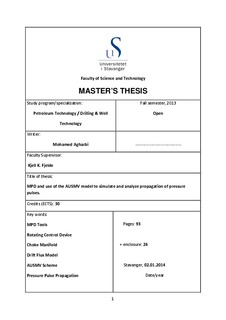| dc.description.abstract | Offshore drilling is one of our era’s most challenging operations in the petroleum industry. Conventional drilling methods face difficulty in certain prospects, such as drilling in deep water reservoirs and depleted offshore reservoirs. This is due to the narrow drilling window present in these types of reservoirs. There is a small margin between the pore pressure gradient and the fracture gradient which causes difficulty to drill with conventional methods. Managed pressure drilling (MPD) has emerged as a solution to many of the conventional drilling problems like kick scenarios, lost circulation, stuck pipe problems and drilling in depleted reservoirs. MPD provides us with precise control in these narrow margin wells by allowing drilling close to the pore-pressure gradient. The conventional drilling problems are either reduced or eliminated completely by using MPD technology.
Most of MPD is executed by drilling in a closed well loop utilizing a Rotating Control Device (RCD) with a minimum of one drill string Non-Return Valve, and a Drilling Choke Manifold. The choke can be controlled manually or automatically. In today’s world the most common type is the automatic choke regulation. It requires PID controllers as a regulation technique, this is based on the difference between measured pressure vs required pressure. In addition to that, the automation process is supported by hydraulic simulator models. Wellbore control is very precise in MPD, assuming that the wellbore is sealed and able to contain the pressure. If this is the case, it is then possible to monitor the pressure throughout the wellbore in real time at the surface. Pressure changes are seen immediately in a closed system. MPD offers more precise control of the annular wellbore pressure profiles; hence influxes and losses are detected immediately. Safety of personnel and equipment during drilling is improved. Drilling economics is improved in MPD due to the reduction of drilling mud costs and reduction in non-productive time.
The Drift Flux model is used in the petroleum industry among other things to evaluate transient flow responses of drilling operations. It has its roots in the laws of conservation for two phase flow, and its goal is to describe the characteristics of flow in pipes or wells. The AUSMV (Advection Upstream Splitting Method) scheme is a hybrid flux-vector splitting scheme. The AUSMV scheme is used in this thesis to simulate different scenarios concerning propagation of pressure pulses in a well.
In the simulations we studied the pressure pulse propagation caused by pump start up and choke valve adjustments. It was demonstrated what effect friction has on the pulses and if the differences between having a one-phase and two-phase flow system. In the latter case, we also show how the gas volume content in the well affects the propagation velocities.
Pressure pulse propagation caused by pump start up and choke valve adjustments is studied in the simulations with the help of the AUSMV scheme. Studying the propagation of pressure pulses generated by adjusting the choke, is of importance in MPD because situations arise where we have to increase the choke pressure to avoid kick. In a MPD system, presence of gas might easily occur since the system is designed for taking small gas kicks while drilling. Hence, in a long extended reach well, this is maybe an effect that one has to consider when working with an automated choke regulation system. After a given choke adjustment, one must give the well time to respond before an additional choke adjustment is introduced.
The results of the simulations show that the sonic velocity depends both on gas fraction and pressure. If we operate with gas in a well, typically we find that the sonic velocity is reduced most at the top of the well. As the pressure increases with well depth, the sonic wave propagation velocity increases. Therefore, if we adjust the choke by making fast updates based on frequent measurements in long wells, there is a possibility that this “time lag” is a factor which must be taken into account. This will particularly apply to underbalanced drilling systems where we know there will be significant volumes of gas in the well. | no_NO |
